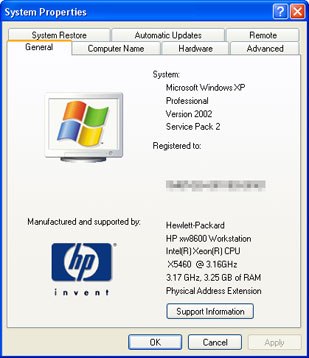Bryan Hoff compares HP's new xw8600 workstation with the xw8400. Is it worth the upgrade? Read on.
There comes a time in every guy's life when he just wants to go fast. Some buy sports cars, some take up BASE-jumping, while others decide it's time to upgrade their workstations. If you fall into the latter category, then read on.
HP's new xw8600 system is ideal for broadcast and video editing, oil and gas exploration and 3D graphics creation, to name a few. Speed and customizability are the order of the day.
Configure to Your Heart's Content
Pricing for the xw8600 begins at $1,926, while the system I tested included two quad core Xeon 5460 processors clocked at 3.16 GHz, a 1333 MHz frontside bus, 4 GB of RAM, a 160 GB SATA hard drive and a Quadro FX 1700 video card, and costs $7,386. Aside from being the fastest system I've ever tested, it's also the most expandable, with a potential 128 Gigabytes of memory, with the addition of RAM risers. For a little perspective, the 8600's predecessor, the 8400, could address a maximum of 32 Gigabytes. Perhaps the biggest change, though, is the bandwidth provided by the second-generation PCI-E video; the dual x16 video slots offer a total of 16 GB/s throughput; 8GB/s in each direction. This, coupled with the increased memory capacity, goes a long way in eliminating bandwidth bottlenecks. Need hard drive space? HP has you covered there as well, with 14 hard drive connections in total. So many, in fact, that there won't be enough room in the case for all of them.
SpecViewPerf 9 Test Results
I ran the SpecViewPerf 9 benchmarking test on the xw8600 to see exactly what has been improved. For the sake of comparison, I've also included the SpecViewPerf results for the xw8400.

HP xw8400
SUM_RESULTS3DSMAXSUMMARY.TXT3dsmax-04 Weighted Geometric Mean = 29.98
SUM_RESULTSCATIASUMMARY.TXTcatia-02 Weighted Geometric Mean = 36.45
SUM_RESULTSENSIGHTSUMMARY.TXTensight-03 Weighted Geometric Mean = 21.83
SUM_RESULTSLIGHTSUMMARY.TXTlight-08 Weighted Geometric Mean = 34.42
SUM_RESULTSMAYASUMMARY.TXTmaya-02 Weighted Geometric Mean = 24.22
SUM_RESULTSPROESUMMARY.TXTproe-04 Weighted Geometric Mean = 28.59
SUM_RESULTSSWSUMMARY.TXTsw-01 Weighted Geometric Mean = 36.90
SUM_RESULTSUGNXSUMMARY.TXTugnx-01 Weighted Geometric Mean = 10.86
SUM_RESULTSTCVISSUMMARY.TXTtcvis-01 Weighted Geometric Mean = 6.357
HP xw8600
SUM_RESULTS3DSMAXSUMMARY.TXT3dsmax-04 Weighted Geometric Mean = 34.05
SUM_RESULTSCATIASUMMARY.TXTcatia-02 Weighted Geometric Mean = 39.31
SUM_RESULTSENSIGHTSUMMARY.TXTensight-03 Weighted Geometric Mean = 38.73
SUM_RESULTSLIGHTSUMMARY.TXTlight-08 Weighted Geometric Mean = 35.93
SUM_RESULTSMAYASUMMARY.TXTmaya-02 Weighted Geometric Mean = 140.9
SUM_RESULTSPROESUMMARY.TXTproe-04 Weighted Geometric Mean = 34.44
SUM_RESULTSSWSUMMARY.TXTsw-01 Weighted Geometric Mean = 56.13
SUM_RESULTSTCVISSUMMARY.TXTtcvis-01 Weighted Geometric Mean = 23.39
SUM_RESULTSUGNXSUMMARY.TXTugnx-01 Weighted Geometric Mean = 25.14
As you can see, the xw8600 beat out the xw8400 in every test, with an especially jaw-dropping result in the Maya test. But how does it perform in real-world testing? Very well, thanks.
Render time
Now it's time for the talent portion of our competition -- our trusty 3ds Max render tests.
Displacement & DOF.max System Time HP xw8400
HP xw8600
Light Gallery System Time HP xw8400
HP xw8600
The new system impressed me with its speedy bucket filling. It's nice to be entertained by buckets filling in rather than waiting for the next one to appear. As you can see by the results, I shaved more than three minutes off the render time for the Displacement & DOF file, and cut the Light Gallery scenes render time almost in half. I have to admit that seeing a result of less than one minute brought a smile to my face.
Keeping Up with the Joneses
It seems that every 12-18 months we're faced with a choice: to upgrade or not to upgrade. With everything the xw8600 brings to the table, the choice seems a lot more clear-cut this time. From its 45 nm process to its fat pipes, and from the massive amount of memory it can handle to the choice of video card and operating system, not upgrading seems almost out of the question, assuming you've got the budget for it. For such a powerful beast, it's reasonably quiet. It's also an extremely expandable system with options to preload Linux, Windows XP or Vista in both 32 and 64-bit configurations.
One area where I was hoping to see a change is in case design, where a little modernization is in order. It's not that the case design is unattractive or old fashioned; it's just not as cutting edge as it could be. However, as I unpacked the system while mulling over this very subject, I noticed a different-looking workstation. HP had applied a case skin from hp.skinit.com, as shown above. If you can't get a redesigned case, skins are the next best thing. This one covers the entire workstation (front bezel, side panels and top), and costs $64.95. It also goes a long way in breathing new life into a case design that's a few years old, and it looks even better sitting on your desk.
Bryan Hoff is a multifaceted artist and writer. A web designer, digital artist and animator, his credits include movie and television effects, online games, 3D corporate animation, Flash and traditional website design. His writing credits include articles for LinuxWorld, Element K Journals and InformIT, covering topics like Photoshop effects, Linux 3D graphics applications, Web and HTML design, RSS feeds and painting with a graphics tablet. Hoff has written ebooks on blogging and website creation for beginners and co-authored the book Moving from Windows to Linux.









